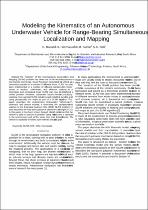 ResearchSpace
ResearchSpace
Modeling the kinematics of an autonomous underwater vehicle for range-bearing Simultaneous Localization and Mapping
JavaScript is disabled for your browser. Some features of this site may not work without it.
- ResearchSpace
- →
- Research Publications/Outputs
- →
- Conference Publications
- →
- View Item
| dc.contributor.author |
Matsebe, O

|
|
| dc.contributor.author |
Holtzhausen, S

|
|
| dc.contributor.author |
Kumile, CM

|
|
| dc.contributor.author |
Tlale, NS

|
|
| dc.date.accessioned | 2009-01-08T11:29:06Z | |
| dc.date.available | 2009-01-08T11:29:06Z | |
| dc.date.issued | 2008-12 | |
| dc.identifier.citation | Matsebe, O, Holtshausen, S, Kumile, CM et al. 2008. Modeling the kinematics of an autonomous underwater vehicle for range-bearing Simultaneous Localization and Mapping. 15th International Conference on Mechatronics and Machine Vision in Practice. Auckland, New Zealand, 2-4 December 2008. pp 6 | en |
| dc.identifier.isbn | 9780473135324 | en |
| dc.identifier.uri | http://hdl.handle.net/10204/2774 | |
| dc.description | 15th International Conference on Mechatronics and Machine Vision in Practice. Auckland, New Zealand, 2-4 December 2008. | en |
| dc.description.abstract | The “solution” of the Simultaneous Localisation and Mapping (SLAM) problem has been one of the notable successes of the robotics community. SLAM has been formulated and solved as a theoretical problem in a number of different forms. SLAM has also been implemented in a number of different domains from indoor robots to outdoor, underwater, and airborne systems. At a theoretical and conceptual level, SLAM can now be considered a solved problem. However, substantial issues remain in practically realizing more general SLAM solutions and notably in building and using perceptually rich maps as part of a SLAM algorithm. This paper describes the Autonomous Underwater Vehicle (AUV) kinematic and sensor models, it overviews the basic theoretical solution to the Extended Kalman Filter (EKF) SLAM problem, it also describes the way-point guidance based on Line of Sight (LOS). In this paper, it has been shown through Matlab simulation that the vehicle is able to localize its position using features that it observes in the environment and at the same time map those features. The vehicle is expected to follow a pre-defined sinusoidal path. | en |
| dc.language.iso | en | en |
| dc.subject | Automatic guided vehicle (AGV) | en |
| dc.subject | Simultaneous localization and mapping (SLAM) | en |
| dc.subject | Kalman Filter | en |
| dc.title | Modeling the kinematics of an autonomous underwater vehicle for range-bearing Simultaneous Localization and Mapping | en |
| dc.type | Conference Presentation | en |
| dc.identifier.apacitation | Matsebe, O., Holtzhausen, S., Kumile, C., & Tlale, N. (2008). Modeling the kinematics of an autonomous underwater vehicle for range-bearing Simultaneous Localization and Mapping. http://hdl.handle.net/10204/2774 | en_ZA |
| dc.identifier.chicagocitation | Matsebe, O, S Holtzhausen, CM Kumile, and NS Tlale. "Modeling the kinematics of an autonomous underwater vehicle for range-bearing Simultaneous Localization and Mapping." (2008): http://hdl.handle.net/10204/2774 | en_ZA |
| dc.identifier.vancouvercitation | Matsebe O, Holtzhausen S, Kumile C, Tlale N, Modeling the kinematics of an autonomous underwater vehicle for range-bearing Simultaneous Localization and Mapping; 2008. http://hdl.handle.net/10204/2774 . | en_ZA |
| dc.identifier.ris | TY - Conference Presentation AU - Matsebe, O AU - Holtzhausen, S AU - Kumile, CM AU - Tlale, NS AB - The “solution” of the Simultaneous Localisation and Mapping (SLAM) problem has been one of the notable successes of the robotics community. SLAM has been formulated and solved as a theoretical problem in a number of different forms. SLAM has also been implemented in a number of different domains from indoor robots to outdoor, underwater, and airborne systems. At a theoretical and conceptual level, SLAM can now be considered a solved problem. However, substantial issues remain in practically realizing more general SLAM solutions and notably in building and using perceptually rich maps as part of a SLAM algorithm. This paper describes the Autonomous Underwater Vehicle (AUV) kinematic and sensor models, it overviews the basic theoretical solution to the Extended Kalman Filter (EKF) SLAM problem, it also describes the way-point guidance based on Line of Sight (LOS). In this paper, it has been shown through Matlab simulation that the vehicle is able to localize its position using features that it observes in the environment and at the same time map those features. The vehicle is expected to follow a pre-defined sinusoidal path. DA - 2008-12 DB - ResearchSpace DP - CSIR KW - Automatic guided vehicle (AGV) KW - Simultaneous localization and mapping (SLAM) KW - Kalman Filter LK - https://researchspace.csir.co.za PY - 2008 SM - 9780473135324 T1 - Modeling the kinematics of an autonomous underwater vehicle for range-bearing Simultaneous Localization and Mapping TI - Modeling the kinematics of an autonomous underwater vehicle for range-bearing Simultaneous Localization and Mapping UR - http://hdl.handle.net/10204/2774 ER - | en_ZA |





